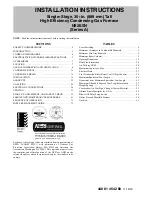
30
FORGE OUTDOOR COAL FURNACE • OWNER'S MANUAL
Creosote - Formation and Need for Removal. When wood is burned slowly, it
produces tar and other organic vapors, which combine with expelled moisture
to form creosote. The creosote vapors condense in the relatively cool chimney
flue of a slow-burning fire. As a result, cresote residue accumulates on the flue
lining. When ignited this creosote makes an extremely hot fire.
When coal is burned, it will produce soot, a black, ash-like coating on the
inside of the firebox and chimney.
The chimney connector and chimney should be inspected at least twice
monthly during the heating season to determine if creosote or soot buildup
has occurred, and to check for corrosion or condensation. If creosote has
accumulated it should be removed to reduce the risk of a chimney fire. If soot
has accumlated it should be removed to prevent air flow blockage.
The chimney and chimney connector must be clean and in good condition.
MAINTENANCE SECTIONS
Refer to the Preventive Maintenance Schedule for the recommended intervals
with which to perform these maintenance items.
3-1. Water Level
Open the sight gauge valve. The sight gauge tube will fill to indicate the level
of water in the outdoor furnace. Be sure to close the sight gauge valve after
checking water level. The sight gauge valve and tube will drain when the valve
is closed.
3-2. Vent Cap
Check that the vent cap fits loosely on the vent opening.
The outdoor furnace vent cap must fit loosely on the vent opening (Fig. 1). Do not force
the cap down or try to seal it tightly onto the vent pipe. Do not extend or restrict the
vent pipe or opening. DO NOT ALLOW THE OUTDOOR FURNACE TO BE PRESSURIZED.
3-3. Ash
If burning bituminous, a 3-4" bed of ash on the shaker grates must be
maintained to protect the grates from the excessive heat of the coal fire.
If burning anthracite, the ash bed should be thinner.
Monitor the ash during removal from the ash collection chamber to determine
if the proper amount of shaker grate operation is being performed (see Ash
Cleanout section for proper procedures).













































